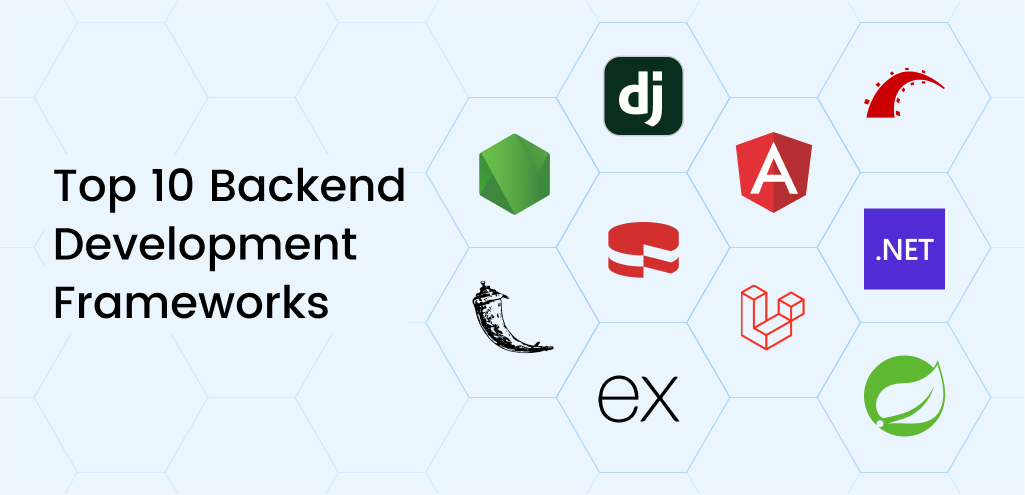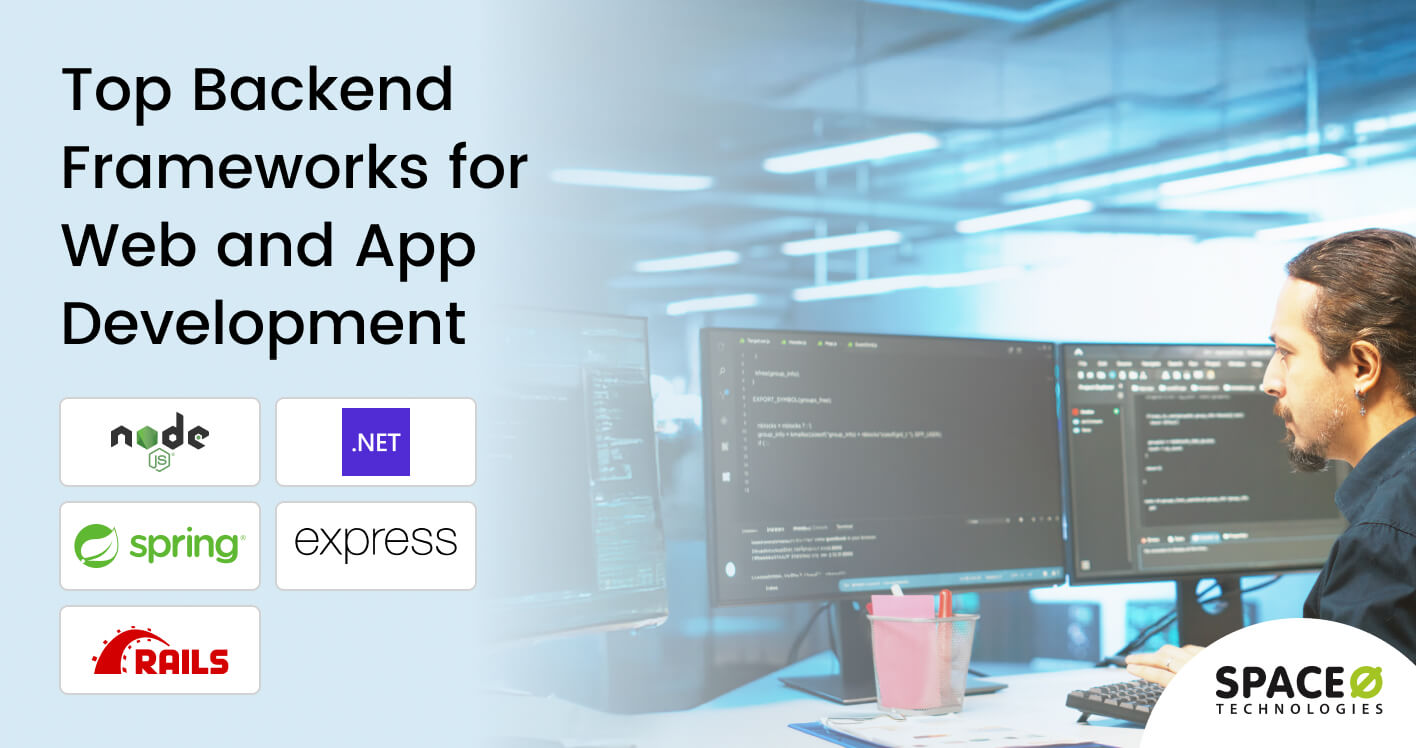Table of Contents
Wondering which backend framework is best for your web or mobile app? Or how to choose a framework that ensures scalability, fast performance, and easier maintenance? You’re not alone.
For many businesses, selecting the right backend framework is one of the toughest early decisions in the development journey. The framework you choose directly affects how quickly your team can build, how well your app scales, and how secure it remains over time.
As a leading backend development company, we’ve seen firsthand how the right backend framework can make or break a project. With so many powerful options available today, including Node.js, Django, Laravel, Spring, and Flask, understanding their strengths and ideal use cases is key to making an informed decision.
In this blog, we’ll explore the top backend frameworks, compare their features, and break down which frameworks are best suited for different types of projects. Whether you’re planning a startup MVP or an enterprise-grade application, this guide will help you make the right decision for your backend architecture.
What Is a Backend Framework?
A backend framework is a software framework designed to help developers build and manage the server-side of web and mobile applications efficiently. It provides pre-built components, libraries, and tools that handle common backend tasks, such as database interactions, server routing, authentication, and API management.
Essentially, it acts as a foundation, allowing developers to focus on the unique logic of their applications rather than reinventing the wheel for every project.
While frontend frameworks like React, Angular, or Vue.js focus on creating the user interface and handling the visual experience of an application, backend frameworks work behind the scenes. They manage how data is stored, processed, and delivered to the frontend, ensuring smooth, secure, and reliable application performance.
Top 10 Backend Development Frameworks: Head-To-Head Comparison
With dozens of backend frameworks available today, choosing the right one can be overwhelming. To help you make an informed decision, here’s a side-by-side comparison of the top 10 backend frameworks:
| Backend Framework | G2 Score | Best For |
|---|---|---|
| 4.8 Stars | Real-time, scalable applications such as chat apps, streaming platforms, and collaborative tools. | |
| 4.3 Stars | Enterprise-grade applications requiring strong security, reliability, and Microsoft ecosystem integration. | |
| 4.5 Stars | Rapid development of MVPs and startups looking for quick deployment and clean code structure. | |
| 4.5 Stars | Dynamic, single-page web applications with a strong focus on performance and maintainability. | |
| 3.9 Stars | Small to mid-sized web applications needing quick development and a structured MVC framework in PHP. | |
| 4.5 Stars | Data-driven applications that demand scalability, security, and fast development with Python. | |
| 4.7 Stars | Feature-rich PHP applications with elegant syntax, built-in tools, and excellent API support. | |
| 4.5 Stars | Lightweight, customizable Python applications where developers want flexibility and control. | |
| 4.5 Stars | Complex, large-scale enterprise systems requiring modularity, strong security, and high performance. | |
| 4.5 Stars | Fast, lightweight, and scalable RESTful APIs or web applications using JavaScript and Node.js. |
Now that you’ve seen how the leading backend frameworks stack up against each other, let’s take a closer look at each one in detail, exploring their core features, benefits, and the types of projects they’re best suited for.
Confused About Which Backend Framework to Choose?
Let our experts help you pick the ideal technology stack for your project. From Node.js to Django, we’ve built them all.

Detailed Overview of Best Backend Frameworks

Choosing the right backend framework can make or break your application’s performance, scalability, and development speed. With so many options available, it’s important to understand the strengths, use cases, and benefits of each.
Node.js
Node.js is an open-source, cross-platform runtime environment that allows developers to execute JavaScript code on the server side. Unlike traditional server environments that rely on multi-threaded request handling, Node.js uses a single-threaded, event-driven architecture.
It is one of the top JavaScript development frameworks and allows developers to create full-stack JavaScript applications, reducing complexity and improving productivity. Node.js is particularly favored for projects that demand speed, low latency, and the ability to manage large volumes of simultaneous requests.
Key Benefits of Node.js
- High Performance: The non-blocking, event-driven architecture ensures that multiple requests are processed efficiently without slowing down the server.
- JavaScript Across the Stack: Developers can use a single language for both client-side and server-side code, improving collaboration and reducing development time.
- Rich Ecosystem: Node Package Manager (NPM) provides access to over a million modules, allowing developers to integrate functionalities quickly without building from scratch.
- Real-Time Applications: Perfect for chat apps, live streaming platforms, collaboration tools, and gaming applications where instant updates are critical.
- Scalability: Supports horizontal scaling and microservices architecture, making it suitable for projects that need to grow over time.
- Active Community: A large and active developer community ensures continuous updates, tutorials, and support for new technologies.
When To Use Node.js
- Developing real-time applications like chat apps, collaboration platforms, or live dashboards.
- Building RESTful APIs or GraphQL services for web and mobile applications.
- Projects requiring high concurrency and fast data processing.
- Startups or teams seeking full-stack JavaScript development to streamline workflows.
- Applications with microservices architecture or serverless deployment requirements.
ASP.NET
ASP.NET is a robust, open-source web framework developed by Microsoft for building dynamic web applications, APIs, and enterprise-grade backend systems. It runs on the .NET platform and supports multiple programming languages, including C#, F#, and VB.NET. ASP.NET provides a unified framework that integrates seamlessly with other Microsoft technologies.
The framework offers several development models, including ASP.NET MVC, ASP.NET Web API, and ASP.NET Core. The latter is cross-platform and optimized for high performance and scalability. With built-in features for security, data access, and server-side rendering, ASP.NET allows developers to create robust, maintainable, and enterprise-ready applications efficiently.
Key Benefits of ASP.NET
- High Performance: ASP.NET Core, in particular, is optimized for speed and can handle high-volume traffic with minimal latency.
- Cross-Platform: ASP.NET Core supports Windows, Linux, and macOS, giving developers flexibility in deployment.
- Security Features: Built-in authentication, authorization, and data protection features reduce vulnerabilities and protect applications.
- Scalability: Supports microservices architecture and cloud deployment, making it suitable for enterprise-level applications.
- Rich Ecosystem: Strong integration with Microsoft tools such as Azure, Visual Studio, and SQL Server accelerates development and deployment.
When To Use ASP.NET
- Developing enterprise-grade web applications that require high reliability, security, and maintainability.
- Building web APIs or backend services for large-scale applications.
- Projects that need seamless integration with Microsoft technologies such as Azure cloud, SQL Server, or Office 365.
- Applications requiring cross-platform support without compromising performance.
- Teams or organizations with experience in C# or the .NET ecosystem.
Ruby on Rails
Ruby on Rails, often called Rails, is an open-source backend framework written in the Ruby programming language. Introduced in 2004 by David Heinemeier Hansson, Rails follows the Model-View-Controller (MVC) architecture, providing a structured approach to web application development. It emphasizes convention over configuration, meaning developers can write less code while achieving more functionality, which accelerates development.
Rails comes with a rich set of built-in tools and libraries that handle everything from database management and routing to security and testing. Its focus on rapid development, simplicity, and clean code makes it a favorite among startups and companies looking to launch web applications quickly without compromising maintainability.
Key Benefits of Ruby on Rails
- Rapid Development: Pre-built conventions and scaffolding allow developers to build applications quickly.
- Clean and Maintainable Code: Follows best practices and MVC architecture, making code easier to read, maintain, and scale.
- Built-in Tools: Comes with integrated solutions for routing, database migrations, testing, and security, reducing the need for third-party libraries.
- Scalability: Supports modular design and can be optimized to handle growing traffic with caching and background job processing.
- Strong Community Support: A mature ecosystem with extensive documentation, gems (libraries), and active developers ensures continuous improvement and problem-solving.
- Cost-Effective Development: Ideal for startups and MVPs due to faster development cycles and fewer resources required.
When To Use Ruby on Rails
- Building startups or MVPs where speed to market is critical.
- Developing database-backed web applications like e-commerce platforms, content management systems, or SaaS products.
- Projects that benefit from convention-over-configuration, reducing setup time and boilerplate code.
- Applications requiring rapid prototyping or frequent updates.
- Teams looking for a framework with a mature ecosystem and strong community support.
Angular
Angular is an open-source frontend framework developed and maintained by Google for building dynamic, single-page applications (SPAs). While it’s mainly used on the client side, Angular often works closely with backend frameworks to create full-stack applications. Its component-based architecture, two-way data binding, and dependency injection make it easy to build complex, responsive, and maintainable web interfaces.
An experienced Angular development company can pair Angular with a backend framework like Node.js, ASP.NET, or Django for seamless frontend-backend integration. This allows businesses to build robust, scalable applications with clean separation of concerns.
Key Benefits of Angular
- Dynamic and Interactive UIs: Supports two-way data binding for real-time updates between the UI and backend.
- Component-Based Architecture: Encourages modular, reusable, and maintainable code.
- Integration with Backend Services: Works well with RESTful APIs and GraphQL to communicate efficiently with backend frameworks.
- Cross-Platform Development: Supports web, mobile (with Ionic), and desktop applications.
- Strong Community and Support: Maintained by Google with frequent updates, extensive documentation, and a large developer community.
When To Use Angular
- Building single-page applications (SPAs) with heavy client-side interactivity.
- Projects requiring tight integration with backend APIs for data-driven applications.
- Developing full-stack applications with frameworks like Node.js or ASP.NET on the backend.
- Applications that need modular, maintainable frontend code for large-scale projects.
- Teams seeking cross-platform solutions using a single frontend framework.
CakePHP
CakePHP is an open-source PHP backend framework designed to make web application development faster and simpler. Following the Model-View-Controller (MVC) architecture, CakePHP provides a structured approach to coding, which helps developers build maintainable and scalable applications efficiently.
With built-in tools for database access, caching, validation, authentication, and security, CakePHP is particularly suited for developers who want a robust backend framework without reinventing common components. Its simplicity and flexibility make it a popular choice for small to medium-sized web applications.
Key Benefits of CakePHP
- Rapid Development: Built-in scaffolding, code generation, and conventions allow developers to create applications quickly.
- Structured and Maintainable Code: MVC architecture promotes clean separation of concerns, making code easier to read and maintain.
- Security Features: Provides built-in tools for input validation, SQL injection prevention, CSRF protection, and authentication.
- Flexibility and Extensibility: Modular design allows integration of plugins and extensions to add functionality without disrupting the core framework.
- Active Community: A mature ecosystem with active developers and extensive documentation supports continuous learning and troubleshooting.
- Database Integration: Simplified database access and ORM (Object-Relational Mapping) support for working with multiple database types.
When To Use CakePHP
- Developing small to medium-sized web applications where rapid development is a priority.
- Projects that require secure, maintainable, and structured backend code.
- Applications needing a quick setup with minimal configuration.
- Teams looking for PHP-based solutions with strong community support.
- Web applications like content management systems, e-commerce platforms, and internal business tools.
Django
Django is a high-level, open-source Python backend framework designed to enable the rapid development of secure and maintainable web applications. Introduced in 2005, Django follows the Model-View-Template (MVT) architecture, which enforces clean code organization and a clear separation of concerns.
Django comes with a comprehensive set of built-in tools and features, including an ORM (Object-Relational Mapping) system, authentication, URL routing, and an admin interface. This allows developers to focus on building application-specific features rather than reinventing core functionality.
Key Benefits of Django
- Rapid Development: Built-in tools and a robust standard library reduce development time significantly.
- Security: Provides protection against common web vulnerabilities such as SQL injection, cross-site scripting (XSS), and cross-site request forgery (CSRF).
- Scalability: Supports high-traffic applications and can be easily scaled with caching, load balancing, and microservices.
- Clean and Maintainable Code: Follows MVT architecture and encourages best practices for maintainable and reusable code.
- Built-in Admin Interface: Automatically generates a powerful admin panel for managing application data.
- Extensive Ecosystem: Large community, third-party packages, and thorough documentation simplify integration and troubleshooting.
When To Use Django
- Building data-driven web applications, such as e-commerce platforms, content management systems, or SaaS products.
- Python app development projects that require fast development without compromising security or scalability.
- Applications needing robust authentication and user management features out of the box.
- Startups or teams leveraging Python for full-stack development or data-intensive applications.
- Enterprise-grade applications where maintainable, modular, and extensible code is critical.
Laravel
Laravel is an open-source PHP backend framework known for its elegance, simplicity, and developer-friendly syntax. It is designed to simplify and accelerate common backend tasks, such as routing, authentication, caching, and database management.
With a rich ecosystem that includes Eloquent ORM, Blade templating engine, artisan CLI, and built-in support for RESTful APIs, Laravel empowers developers to build modern web applications efficiently. Its focus on developer productivity, combined with strong community support, makes it a popular choice for startups, SMEs, and enterprise applications alike.
To harness these benefits, you can work with an experienced Laravel development company like Space-O Technologies with proven expertise in building Laravel-based back-end platforms.
Key Benefits of Laravel
- Elegant Syntax and Developer-Friendly: Intuitive and readable code improves productivity and reduces development errors.
- Rapid Development: Pre-built tools like artisan CLI, scaffolding, and packages accelerate development.
- Built-in Security: Features such as hashed passwords, encryption, and protection against SQL injection and CSRF attacks ensure secure applications.
- MVC Architecture: Promotes structured, maintainable, and testable code.
- Database Management: Eloquent ORM simplifies database interactions, migrations, and relationships.
- Robust Ecosystem: Includes features for queues, task scheduling, caching, and API development, reducing reliance on third-party libraries.
When To Use Laravel
- Building web applications ranging from small projects to large-scale enterprise solutions.
- Projects requiring fast development cycles with clean and maintainable code.
- Applications that need secure authentication, authorization, and data handling out of the box.
- Startups or teams leveraging PHP for backend development who want a modern, feature-rich framework.
- Web apps like e-commerce platforms, SaaS products, and content management systems.
Flask
Flask is a lightweight, open-source Python backend framework designed for simplicity and flexibility. Unlike full-featured frameworks like Django, Flask follows a microframework philosophy, providing only the essential components needed to build a web application. Developers can then add extensions or third-party libraries as required, making Flask highly modular and customizable.
Flask is ideal for projects that require simplicity, fine-grained control, and quick development cycles. Its minimalistic approach allows developers to build APIs, web applications, and prototypes without unnecessary overhead while still supporting scalable and production-ready architectures.
Key Benefits of Flask
- Lightweight and Flexible: Minimal built-in functionality allows developers to choose the components and tools they need.
- Easy to Learn: Simple and intuitive API makes it beginner-friendly for Python developers.
- Extensible: A Wide range of extensions and third-party libraries allows seamless integration of features such as authentication, database management, and caching.
- Rapid Prototyping: Ideal for quickly building APIs, prototypes, and small-scale applications.
- Scalable: Can be expanded to handle larger applications and integrated into a microservices architecture.
- Strong Community Support: Active Python developer community provides tutorials, plugins, and solutions for common challenges.
When To Use Flask
- Building lightweight web applications or RESTful APIs where simplicity is key.
- Projects requiring fine-grained control over architecture and components.
- Rapid prototyping or MVP development for startups.
- Applications that may grow into microservices-based systems over time.
- Teams prefer Python-based solutions without the overhead of a full-stack framework.
Spring
Spring is a comprehensive, open-source Java backend framework designed to simplify the development of enterprise-grade applications. Its modular architecture allows developers to use only the components they need, while Spring Boot, a convention-over-configuration extension, streamlines setup and deployment by providing pre-configured templates, embedded servers, and production-ready defaults.
Spring supports dependency injection, aspect-oriented programming, and robust integration with databases and messaging systems, making it a popular choice for complex, scalable, and maintainable applications. It is widely used in enterprise environments, microservices architectures, and cloud-based deployments, offering a mature ecosystem with strong community and corporate support.
Key Benefits of Spring
- Rapid Development with Spring Boot: Pre-configured templates, auto-configuration, and embedded servers reduce setup time.
- Scalability: Well-suited for high-traffic, enterprise-grade applications and microservices.
- Security: Built-in support for authentication, authorization, encryption, and integration with Spring Security.
- Flexibility: Modular design allows selective use of components based on project requirements.
- Robust Ecosystem: Integrates seamlessly with databases, messaging systems, cloud platforms, and third-party libraries.
- Maintainable and Testable Code: Dependency injection and AOP promote clean, modular, and testable code.
When To Use Spring
- Building large-scale, enterprise-grade applications requiring high reliability and maintainability.
- Developing microservices or cloud-native applications with scalable architecture.
- Projects that require robust security features and compliance with enterprise standards.
- Applications integrating with complex data sources, messaging queues, or third-party systems.
- Teams with expertise in Java or Kotlin looking for a proven, production-ready backend framework.
Express.js
Express.js is a minimalistic, fast, and flexible Node.js backend framework that simplifies building web applications and APIs. Released in 2010, it provides a lightweight layer over Node.js, offering robust routing, middleware support, and HTTP utility methods to streamline server-side development.
Express.js is often called the “de facto” standard for Node.js web development due to its simplicity, performance, and extensibility. It allows developers to build single-page applications, RESTful APIs, and complex web services quickly, while maintaining full control over the application structure and behavior.
Key Benefits of Express.js
- Lightweight and Fast: Minimal overhead ensures high performance and low latency.
- Flexible and Unopinionated: Gives developers freedom to structure the application as needed without enforcing strict conventions.
- Middleware Support: Allows easy integration of custom and third-party middleware for authentication, logging, and request handling.
- Seamless Node.js Integration: Fully leverages Node.js features like asynchronous I/O and event-driven architecture.
- Rich Ecosystem: Works well with a variety of libraries, databases, and frontend frameworks.
- Active Community: Strong community support and numerous tutorials, plugins, and extensions available.
When To Use Express.js
- Building RESTful APIs for web or mobile applications.
- Developing single-page applications (SPAs) with a lightweight backend.
- Projects that require full control over server architecture and routing.
- Applications needing fast, scalable, and efficient handling of multiple requests.
- Teams leveraging Node.js for full-stack JavaScript development.
Build a Scalable Backend with the Right Framework
Partner with Space-O Technologies to design, develop, and deploy high-performance backend systems that power your app’s success.
Need Help Choosing the Right Backend Development Framework For Your Project?
Selecting the right backend development framework is one of the most critical decisions for the success of any web or mobile application. The framework you choose affects performance, scalability, security, and long-term maintainability, and it should align with your project goals, team expertise, and technology requirements.
With so many options available (Node.js, Django, Laravel, Spring Boot, Express.js, and more), it can be challenging to determine which framework best fits your needs. Each framework comes with its own strengths, trade-offs, and ideal use cases. Making the wrong choice can lead to slower development, higher costs, and future scalability challenges.
This is where Space-O Technologies comes in. When you hire backend developers from our team, you gain access to 15+ years of software development experience across industries. Our expert backend developers help businesses choose and implement the right technology stack to build robust, high-performance, and scalable backend systems tailored to your specific needs.
From designing APIs and database architectures to integrating advanced security and optimizing performance, we deliver end-to-end backend solutions tailored to your project requirements.
Ready to build a backend that drives your application forward? Connect with us today for a free consultation, and let our experts guide you in choosing the perfect framework for your project.
FAQs on Choosing the Right Backend Framework
Which backend framework is best for startups and MVP development?
For startups and MVPs, frameworks that enable rapid development, minimal setup, and scalable architecture are ideal. Popular choices include Ruby on Rails and Laravel, which offer built-in tools, convention-over-configuration design, and strong community support. Node.js and Flask are also great for lightweight, fast prototypes that may evolve into complex applications.
How do I choose the right backend framework for my project?
Choosing a backend framework depends on your project requirements, team expertise, scalability needs, and performance goals. Consider factors like:
- Programming language preference
- Ecosystem and libraries available
- Security and maintainability features
- Suitability for your application type (real-time, data-intensive, enterprise-grade, or MVP)
- Community support and long-term viability
Can a backend framework affect my app’s scalability and performance?
Yes, the choice of backend framework directly impacts performance, scalability, and maintainability. Event-driven frameworks like Node.js handle high concurrency efficiently, while frameworks like Spring or Django offer robust structures for large-scale applications. The right framework ensures faster load times, better resource management, and easier scaling as your user base grows.
Is it better to choose a lightweight framework like Flask or a full-featured one like Django?
It depends on your project needs:
- Flask: Lightweight, flexible, ideal for small apps, APIs, or microservices, giving developers more control over architecture.
- Django: Full-featured, “batteries included,” perfect for data-intensive, large-scale, or security-critical applications.
If you need speed and flexibility, go with Flask; if you need structure and pre-built features, Django is the better choice.
Which backend frameworks are ideal for real-time applications?
Real-time applications, like chat apps, collaboration tools, or live dashboards, require low-latency, event-driven frameworks. Node.js and Express.js are top choices due to their non-blocking, asynchronous architecture. Frameworks that support WebSockets or real-time messaging are also suitable for building responsive, high-performance apps.



